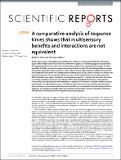Files in this item
A comparative analysis of response times shows that multisensory benefits and interactions are not equivalent
Item metadata
| dc.contributor.author | Innes, Bobby R. | |
| dc.contributor.author | Otto, Thomas U. | |
| dc.date.accessioned | 2019-02-27T11:30:05Z | |
| dc.date.available | 2019-02-27T11:30:05Z | |
| dc.date.issued | 2019-02-27 | |
| dc.identifier | 257663560 | |
| dc.identifier | d7e62217-d8df-48ba-a071-a5e47a8980ac | |
| dc.identifier | 000459799800070 | |
| dc.identifier | 85062215337 | |
| dc.identifier.citation | Innes , B R & Otto , T U 2019 , ' A comparative analysis of response times shows that multisensory benefits and interactions are not equivalent ' , Scientific Reports , vol. 9 , 2921 . https://doi.org/10.1038/s41598-019-39924-6 | en |
| dc.identifier.issn | 2045-2322 | |
| dc.identifier.other | ORCID: /0000-0002-8621-9462/work/54819285 | |
| dc.identifier.uri | https://hdl.handle.net/10023/17159 | |
| dc.description | This work was supported by the Biotechnology and Biological Sciences Research Council (BBSRC, grant number: BB/J01446X/1). | en |
| dc.description.abstract | Multisensory signals allow faster responses than the unisensory components. While this redundant signals effect (RSE) has been studied widely with diverse signals, no modelling approach explored the RSE systematically across studies. For a comparative analysis, here, we propose three steps: The first quantifies the RSE compared to a simple, parameter-free race model. The second quantifies processing interactions beyond the race mechanism: history effects and so-called violations of Miller’s bound. The third models the RSE on the level of response time distributions using a context-variant race model with two free parameters that account for the interactions. Mimicking the diversity of studies, we tested different audio-visual signals that target the interactions using a 2 × 2 design. We show that the simple race model provides overall a strong prediction of the RSE. Regarding interactions, we found that history effects do not depend on low-level feature repetition. Furthermore, violations of Miller’s bound seem linked to transient signal onsets. Critically, the latter dissociates from the RSE, demonstrating that multisensory interactions and multisensory benefits are not equivalent. Overall, we argue that our approach, as a blueprint, provides both a general framework and the precision needed to understand the RSE when studied across diverse signals and participant groups. | |
| dc.format.extent | 10 | |
| dc.format.extent | 2196686 | |
| dc.language.iso | eng | |
| dc.relation.ispartof | Scientific Reports | en |
| dc.subject | Audio-visual reaction times | en |
| dc.subject | Principles of multisensory integration | en |
| dc.subject | Sustained vs. transient signals | en |
| dc.subject | Sequential effects | en |
| dc.subject | Noise | en |
| dc.subject | Perceptual decision making | en |
| dc.subject | BF Psychology | en |
| dc.subject | RC0321 Neuroscience. Biological psychiatry. Neuropsychiatry | en |
| dc.subject | DAS | en |
| dc.subject | BDC | en |
| dc.subject | R2C | en |
| dc.subject.lcc | BF | en |
| dc.subject.lcc | RC0321 | en |
| dc.title | A comparative analysis of response times shows that multisensory benefits and interactions are not equivalent | en |
| dc.type | Journal article | en |
| dc.contributor.institution | University of St Andrews. School of Psychology and Neuroscience | en |
| dc.identifier.doi | https://doi.org/10.1038/s41598-019-39924-6 | |
| dc.description.status | Peer reviewed | en |
This item appears in the following Collection(s)
Items in the St Andrews Research Repository are protected by copyright, with all rights reserved, unless otherwise indicated.

